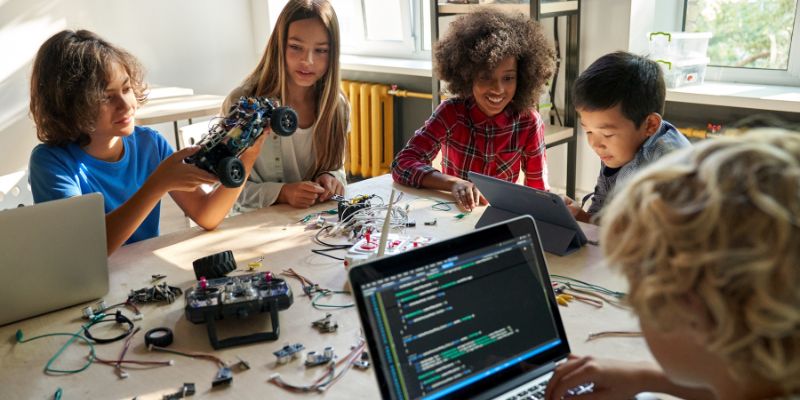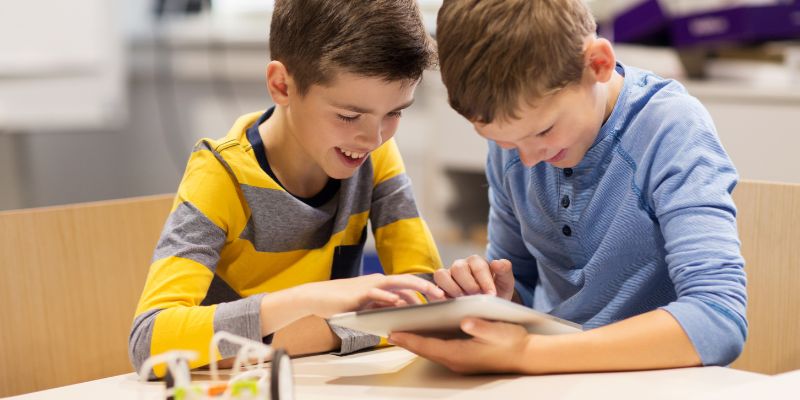This content was last updated on July 3, 2025
This blog is presented by Twin Science, a global education technology company empowering educators through AI-enhanced learning solutions. In today’s digital classrooms, many educators observe that children engage with technology instinctively, often before they even start school.
But how can you as the teacher ensure this digital fluency turns into meaningful, developmentally appropriate learning? If you’ve ever wondered how to nurture your students’ natural interest in technology while promoting AI literacy in a hands-on way, explore classroom-ready AI learning solutions designed to strengthen both curiosity and STEM & AI foundations, available through Twin Educator Portal.
Get in touch to bring personalized, ethical AI learning to your school.
1. Rapid Information Access
How does technology help students access knowledge more quickly and independently? Children can instantly search for answers using digital tools—tablets, computers, phones—encouraging autonomy and curiosity. This access supports project-based learning in STEM and builds the foundation for lifelong inquiry.

2. Developing Core Skills
What foundational skills can be built through edtech tools? Technology supports early literacy, numeracy, and logic development. AI-enhanced games, interactive learning kits, and digital storytelling platforms boost cause-effect reasoning, pattern recognition, and critical thinking in young learners.

3. Supporting Social Interaction
Can technology help students build stronger social skills? Yes, especially when guided. Children who participate in online group games or collaborative digital projects learn to communicate, negotiate, and empathize. Exposure to global classrooms also promotes intercultural awareness and digital citizenship.

4. Nurturing Special Talents
How can students discover and develop their unique strengths through technology? Tools like music composition apps, design software, or coding platforms let students explore beyond the textbook. These hands-on learning opportunities empower children to express their creativity and build confidence in their abilities.
If we learn how to use it in maximum efficiency instead of living in fear and escape from technology in such an age, we can make life much easier for both ourselves and students. If we do the controls we need to do for them and make them understand the limits of using technology, we will achieve this high level of efficiency.
5. Building a Love for Learning
What makes technology effective at motivating students to learn? When learning feels interactive, children stay engaged. Personalized apps adapt to students’ pace and interests—while gamified platforms, videos, and digital tasks make learning feel like play. This helps reinforce STEM and AI concepts through joyful exploration. As AI becomes an everyday part of student life, integrating it into the classroom is no longer optional. Start bringing AI in Education to life today with hands-on tools with Twin Education Solutions, specifically designed for teachers seeking to boost AI literacy and student engagement.

6. Enhancing Communication Skills
How does technology improve children’s ability to communicate? Digital writing, video calls, and messaging apps help students express thoughts clearly and appropriately across different mediums. These interactions improve vocabulary, storytelling, and active listening, which are key communication skills in and beyond school.

7. Developing Digital Literacy
Why is digital literacy critical for today’s learners? Knowing how to use devices isn’t enough. Students must evaluate online information, understand data privacy, and navigate AI-powered tools responsibly. Early exposure builds a strong foundation for ethical and informed tech use.

8. Access to Diverse Resources
How does technology increase access to high-quality learning materials? Digital platforms offer e-books, simulations, and online labs that complement traditional curricula. These resources support differentiated instruction and ensure equity, especially for under-resourced schools in underserved regions.

9. Fueling Creativity
In what ways can technology inspire imagination and innovation? From designing animations to building robots, digital tools unlock creative potential. Students can invent, prototype, and share ideas that go far beyond paper, preparing them to be not just consumers of content, but creators of the future.
10. Preparing for the Future
How does technology shape students’ readiness for tomorrow’s world? By working with evolving tools, students build adaptability and resilience. Exposure to AI, automation, and coding prepares them for careers that haven’t even been invented yet, making STEM and AI education more urgent than ever.
Conclusion
In conclusion, technology can be a powerful ally in students’ development when used thoughtfully and within recommended limits. Technology, when guided by strong pedagogy, supports personalized learning, student voice, and interdisciplinary thinking. With the right tools and teacher AI support, classrooms become spaces for exploration, not just instruction. Get your classroom started today with AI-powered, hands-on learning kits from Twin Science, designed to foster curiosity, build STEM skills, and prepare students for the digital age.
Request a demo to see Twin’s AI-powered STEM ecosystem in action!
Hubert Mazur 🖋️
Design & Technology Teacher




